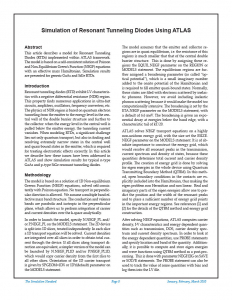Simulation of Resonant Tunneling Diodes Using ATLAS
Abstract
This article describes a model for Resonant Tunneling Diodes (RTDs) implemented within ATLAS framework. The model is based on a self-consistent solution of Poisson and Non-Equilibrium Green’s Function (NEGF) equations with an effective mass Hamiltonian. Simulation results are presented for generic GaAs and SiGe RTDs.
Introduction
Resonant tunneling diodes (RTD) exhibit I-V characteristics with a negative differential resistance (NDR) region. This property finds numerous applications in ultra-fast circuits, amplifiers, oscillators, frequency converters, etc. The physics of NDR region is based on quantum electron tunneling from the emitter to the energy level in the central well of the double barrier structure and further to the collector: when the energy level in the central well is pulled below the emitter energy, the tunneling current vanishes. When modeling RTDs, a significant challenge lies not only quantum transport, but also in finding and resolving extremely narrow states in the central well and quasi-bound states in the emitter, which is required for treating electrostatic effects correctly. In this article we describe how these issues have been addressed in ATLAS and show simulation results for typical n-type GaAs and p-type SiGe resonant tunneling diodes.



